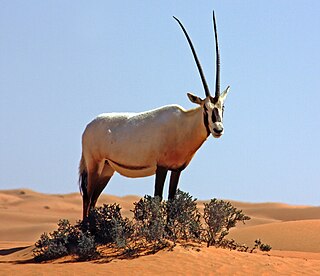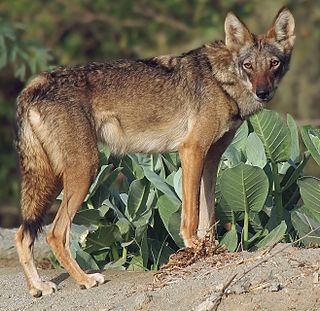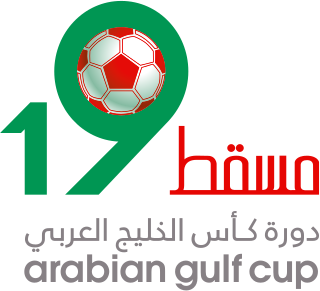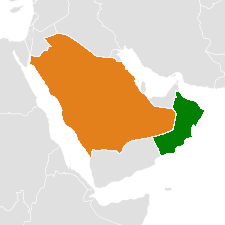
Western Asia—or simply West Asia—is the westernmost subregion of Asia. It includes Anatolia, the Arabian Peninsula, Iran, Mesopotamia, the Levant region, the island of Cyprus, the Sinai Peninsula, and Transcaucasia (partly). The region is considered to be separated from Africa by the Isthmus of Suez in Egypt, and separated from Europe by the waterways of the Turkish Straits and the watershed of the Greater Caucasus. Central Asia lies to its northeast, while South Asia lies to its east. Eight seas surround the region (clockwise): the Aegean Sea, the Black Sea, the Caspian Sea, the Persian Gulf, the Arabian Sea, the Gulf of Aden, the Red Sea, and the Mediterranean Sea.

The Arabian oryx or white oryx is a medium-sized antelope with a distinct shoulder bump, long, straight horns, and a tufted tail. It is a bovid, and the smallest member of the genus Oryx, native to desert and steppe areas of the Arabian Peninsula. The Arabian oryx was extinct in the wild by the early 1970s, but was saved in zoos and private preserves, and was reintroduced into the wild starting in 1980.
Minṭaqah is a first-level administrative division in Saudi Arabia and Chad and for a second-level administrative division in several other Arab countries. It is often translated as region or district, but the literal meaning is "region" or "area".

Blanford's fox is a small fox native to the Middle East and Central Asia. It is listed as Least Concern on the IUCN Red List.

The Arabian wolf is a subspecies of gray wolf which lives on the Arabian Peninsula, the Negev Desert, the Sinai Peninsula, and Jordan.. It is the smallest wolf subspecies, and a desert-adapted subspecies that normally lives in small groups. It is omnivorous, eating carrion and garbage, as well as small to medium-sized prey.

There was a Jewish presence in Oman for many centuries, however, the Jewish community of the country is no longer in existence.
The desert pipistrelle is a species of vesper bat in the genus Hypsugo. It is found in Egypt, Israel, Jordan, Oman, Saudi Arabia, Sudan, and Yemen. Some of the Arabian populations were previously regarded as a separate species, Hypsugo bodenheimeri, but the proposed differences between the two do not hold. Its natural habitats are subtropical or tropical dry shrubland, rocky areas, and hot deserts.
It is estimated that in the Middle East over 900,000 people profess Buddhism as their religion. Buddhist adherents make up just over 0.3% of the total population of the Middle East. Many of these Buddhists are workers who have migrated from Asia to the Middle East since the late 1990s, many from countries that have large Buddhist populations, such as China, Vietnam, Thailand, Sri Lanka, and Nepal. A small number of engineers, company directors, and managers from Japan, Taiwan, Hong Kong, Singapore, and South Korea have also moved to the Middle East.

The history of the Jews in Qatar is very limited. There are few Jews in Qatar.
The article describes the state of race relations and racism in the Middle East. Racism is widely condemned throughout the world, with 174 states parties to the International Convention on the Elimination of All Forms of Racial Discrimination by April 8, 2011. In different countries, the forms that racism takes may be different for historic, cultural, religious, economic or demographic reasons.

The 19th Arabian Gulf Cup was the nineteenth edition of the biannual Gulf Cup competition, and took place in Muscat, Oman, from 4 to 17 January 2009 and was won by Oman for the first time in its history, in a penalty shootout against regional rivals, Saudi Arabia.

The Arabian oryx, also called the white oryx, was extinct in the wild as of 1972, but was reintroduced to the wild starting in 1982. Initial reintroduction was primarily from two herds: the "World Herd" originally started at the Phoenix Zoo in 1963 from only nine oryx and the Saudi Arabian herd started in 1986 from private collections and some "World Herd" stock by the Saudi National Wildlife Research Center (NWRC). As of 2009 there have been reintroductions in Oman, Saudi Arabia, Israel, the United Arab Emirates, and Jordan, and as of 2013 the IUCN Red List classifies the species as vulnerable.
This article include the Bahrain national football team results since its beginnings.
Eremocossus vaulogeri is a species of moth of the family Cossidae. It is found in Senegal, Mauritania, Morocco, Algeria, Libya, Tunisia, Egypt, Jordan, Israel, Syria, Egypt, Oman, Yemen, the United Arab Emirates, Saudi Arabia, Iraq and southern Iran.
This is a list of football games played by the Uzbekistan national football team between 2000 and 2009.

Oman–Saudi Arabia relations refers to the current and historical relations between Sultanate of Oman and Kingdom of Saudi Arabia. Oman has an embassy in Riyadh and a consulate in Jeddah, whilst Saudi Arabia has an embassy in Muscat.
The Arab-Israeli alliance against Iran, also known as Israeli–Sunni Coalition, or Israeli–Sunni Alliance, is an anti-Iranian unofficial coalition in Western Asia, nurtured by the United States. The coordination is taking place in light of the mutual regional security interests of Israel and mostly Sunni Arab States led by Saudi Arabia, and their standoff against Iranian interests across the Middle East - the Iran–Israel proxy conflict and the Iran–Saudi Arabia proxy conflict. The Arab states participating in the coordination group are the core of the Gulf Cooperation Council. Those include Saudi Arabia, United Arab Emirates and Oman.
This is a list of official football games played by Saudi Arabia national football team between 2010 and 2019.
The Arab–Israeli normalization refers to the peace efforts and treaties between the Arab League and Israel, ending the Arab–Israeli conflict. Since the 1970s, there has been a parallel effort made to find terms upon which peace can be agreed to in the Arab–Israeli conflict and also specifically the Israeli–Palestinian conflict. Over the years numerous Arab League countries have signed peace and normalization treaties with Israel, beginning with the Egypt–Israel peace treaty (1979). Despite the failure to implement the Israeli-Lebanese peace accords (1983), more treaties continued with the Israeli-Palestinian peace process (1991-present), Jordan–Israel peace treaty (1994), Abraham accords between Israel and UAE & Bahrain (2020) and Israel–Sudan normalization agreement (2020). Moreover, numerous Arab League members established semi-official relations with Israel, including Oman and Saudi Arabia.








